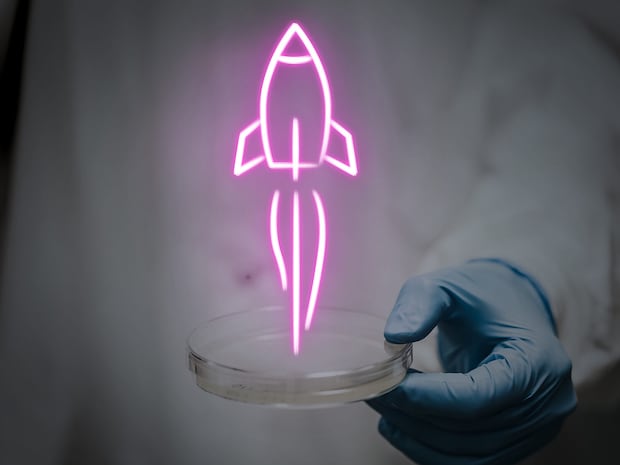JENOPTIK SYIONS® – Shaping Your Imaging solutiONS
A miniaturized digital microscope subsystem designed for giving your life science instrument the power to see.

Optical microscopes have propelled research findings in life sciences and diagnostics for several centuries - microscopy and digital imaging is central to life sciences research, as well as clinical diagnosis and drug discovery. Making the unknown visible is the overall challenge in this disciplines and the key for success.
Digitalization, miniaturization, automation – integrated digital microscopic imaging enables tailored process automation, designed to suit the application to the fullest.
Now, JENOPTIK SYIONS® supports you to be more innovative for a better future.
The electronic & software modularity approach gives you the freedom to develop minimum viable products in a record time and thus rapid prototype testing becomes more easy.
If you are interested in developing innovative life science applications, then JENOPTIK SYIONS® is your partner of choice for rapidly constructed, miniaturized optical engines that will fit into any instrument.
Find out more about JENOPTIK SYIONS®

JENOPTIK SYIONS AT A GLANCE

Innovative
JENOPTIK SYIONS® supports you to be more innovative for a better future
Rapid prototype testing is now even easier. Develop minimum viable products, for completely new applications faster and with fewer resources to improve our lives.

Compact
Minimal footprint and portability
Easily develop a miniaturized microscope subsystem for portable approaches or with minimal footprint that requires less laboratory space.

Efficient
Reduce Time-to-Market
Realize your solution in record time and always focusing on capturing the perfect image.

Flexible
Smart integration into new or existing life science and diagnostic instruments with minimal efforts
JENOPTIK SYIONS® allows a smart integration by eliminating interface issues.

Modular
Modular electronic & software architecture
Realize tailored process automation and integrate any opto mechanical hardware modules and periphery devices without big efforts.
EMPOWERED by JENOPTIK SYIONS®.
Applications in cellomics, proteomics and genomics
JENOPTIK SYIONS enables smart imaging solutions necessary for modern in-vitro diagnostics, cellular imaging in life science or advanced research in drug discovery.The modular software backbone allows easy integration into your specific system environment to always capturing the perfect image of your dedicated sample.JENOPTIK SYIONS is capable for bright field or fluorescence detection, provides superior frame rates for time-lapse applications, includes autofocus control, convinces with wireless design options and much more.
Go on, challenge us and empower your application!
Application Report | Blog
Competitive advantage in the new generation of digital cell imaging
Gaining Competitive Advantage in the Coming Generation of Digital Cell Imaging in Life Science

Today’s customers in the field of life science and in vitro diagnostics want complete, flexible workflow systems that can process in vitro samples quickly with a minimum of human error. Researchers and technicians in cell imaging, and molecular diagnostics in the life sciences are looking for high automation in a small footprint. Here’s how to cater to that market.
Providing accessible solutions in novel cell imaging applications
To gain competitive advantage and dominate the market, understanding the goals of the specific cell imaging application is key. This is a challenge if the application is innovative, and by no means established in the marketplace so that users may have time to express their requirements. Time to market becomes a key issue, since there is an inherent advantage in being a recognized pioneer and leader. It’s a matter of timing to launch a highly competent product, beat your rivals to market and win market share. Additionally, it’s a great advantage to be able to develop generations 2 and 3 of your product efficiently, without having to start from scratch every time.
Faster to market with your cell imaging device
Driving faster to market for your life science imaging instrument or live cell imaging system

There are three main considerations that dictate your imaging product design: performance, versatility, and time-to-market. There are fundamental trade-offs among them and clear market trends in instrument design over recent years. Focus on the application, operator independence, a short learning curve, speed from sample to data and consistent results are high on the list of preferences with life science and clinical users.
Finding optimum balance for your life science analytics applications
In every measurement system, there is an inherent trade-off among performance factors. In photonics, it all has to do with the light budget. Take for example the confocal microscope: it is capable of achieving very high optical resolution, and that entails closing the confocal pinhole. Thus, the available light from the sample becomes restricted; this increases the necessary dwell-time on the sample, resulting in slower frame rates and potential photo-damage of the sample.
Design innovative applications with JENOPTIK SYIONS®
JENOPTIK SYIONS®: a platform for designing a fit-for-purpose molecular diagnostics or cell imaging optical engines for life science research and diagnostic applications

Automation, digitalization, miniaturization – integrated digital microscopic imaging enables tailored process automation, designed to suit the application to the fullest. Human error can be reduced, the cost of running the tests falls, precision can be maximized, and you can make automated in vitro diagnostic solutions accessible to labs and users around the world.
If you’re interested in developing next generation sequencing, cytometry, live cell imaging, detection of circulating tumor DNA, amongst many more specific molecular diagnostic applications, then JENOPTIK SYIONS® from Jenoptik is your partner of choice for rapidly constructed, miniaturized optical engines that will fit into any instrument.
Risk reduction during the CFDA approval of your biomedical device
How Jenoptik can help mitigate the risks of the CFDA approval process for your biomedical devices

Working directly with your component suppliers, including Jenoptik, is one of the best ways to ensure a smooth CFDA/NMPA approval process for your biomedical device.
When introducing a new biomedical device to a new market, the manufacturer is naturally going to worry about the associated risks. For example: Will our biomedical device get the certifications and approvals it needs?
CFDA and FDA certifications for biomedical devices
CFDA, FDA, ISO, MDSAP: what parts of documentation for biomedical devices can be transferred?

Do biomedical device manufacturers really have to write brand-new applications for each national market they enter? Fortunately, for equipment manufacturers, certifications for CFDA, FDA, ISO or MDSAP can be reused now more than ever.
The globalization of the medical device market has led to the proliferation of a veritable alphabet soup of acronyms for the national and international standards-setting agencies that govern such equipment. The paperwork and testing requirements to gain approval from these organizations can seem like a complex, disjointed barrier to manufacturing and selling new products. Do biomedical device manufacturers really have to write brand-new applications for each national market they enter? Fortunately, for biomedical device equipment manufacturers, certifications can be reused now more than ever.
How to achieve CFDA approval for your biomedical device
How to achieve CFDA approval for your biomedical devices?

Gaining CFDA certification for next-generation biomedical devices resembles the processes for approvals from other countries. It’s not as difficult as it sounds.
With more than 1.4 billion people interested in staying healthy, biomedical device manufacturers have golden opportunities in the Chinese market. Hospitals, healthcare organizations and biomedical research laboratories are growing and demanding the same cutting-edge technologies that are found in other countries.
Miniaturized digital microscopes for diagostics and live cell imaging
Your success story with Jenoptik’s miniaturized digital light microscope solution

Traditional microscopes integrated into benchtop instruments are expensive, complicated, need a large amount of lab space, and are loaded with features that are not always required. The JENOPTIK SYIONS® miniaturized digital microscope subsystem focuses on high quality images and versatility, but with a small form factor, ease-of-use, and low cost. As a digital microscope solution in miniature format JENOPTIK SYIONS® consists of inter-compatible modules that work together seamlessly no matter what the final application is. When it comes time to conduct important bioimaging applications, it’s more than a matter of high resolution and sensitive lenses. You need a complete OEM bioimaging solution controlled by software and backed by a team with decades of expertise in light microscopy and digital imaging to advise you and optimize the system to your specific application.
Benefit from Jenoptik´s longstanding experience and expertise in light microscopy and digital imaging
Jenoptik’s technical team has many years of experience with CMOS technology as well as biomedical microscopy and can help you choose new image sensors with the pixel size, resolution, signal-to-noise ratio,dynamic range and other specifications for optimum performance for your particular application.
Can CMOS replace CCD?
In Applications of Chemiluminescence, Can CMOS replace CCD? The advantage of replacing CCD with CMOS for applications where every photon is important.

CCD or CMOS? Although both devices are built on the same fundamental technology, there are differences that have favored one over the other, depending on the application. Chemiluminescence has often been the reserve of CCD detectors because of their relative sensitivity, but they are slower compared to CMOS. Now, CMOS has taken a great leap, and may be favorable to support the more challenging applications where readout speed, power consumption and portability are of the essence.
Exploring the myths of microscope cameras
Exploding the myths of digital microscopy: Is CCD always better than CMOS?

CMOS sensors are very attractive and have such an excellent price-performance ratio that virtually any device today can be equipped with the ability to image – and give any microscope, scientific instrument or medical device a significant competitive advantage. The ability to visualize samples – whether central to the analysis or an apparent “nice to have” feature – can lead to desirable new applications, quality assurance and experimental design.
Biological imaging has evolved from a passive observational collector of descriptive pictures to a keen, versatile and quantitative analytical tool. Microscopic images of tissues and cells provide the basis for characterization and measurements of disease progression, live cell imaging, automated diagnostics, and a host of other activities in the life science and medical diagnostic laboratory. Digital microscopes thus play a crucial role in the signal pathway between the biological sample of interest and the eyes of the scientist.
Do you have any questions? Our experts are happy to help.














